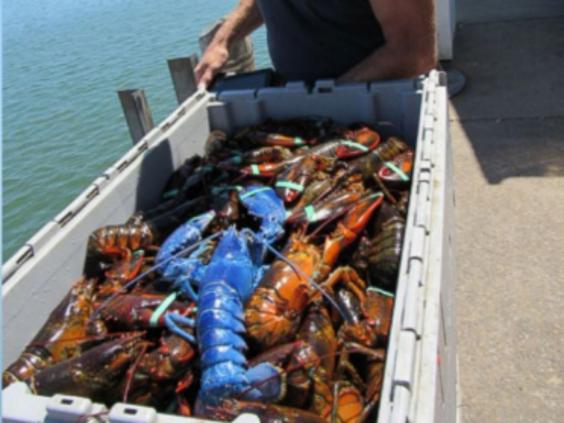 By Selby Frame
By Selby Frame
[Note: This story was picked up by The New York Times, where it ran on the front page of its Science section in 2006.]
Bowdoin Chemistry Professor Ronald Christensen has helped to understand the chemical mechanism responsible for causing an estimated one in a million lobsters to be blue.
These mutated crustaceans are much sought after as rare aquarium specimens and snag news headlines when they occasionally turn up in a lobsterman’s trap. A blue lobster was caught by a Harpswell fisherman last summer and was the subject of attention in the Brunswick Times Record.
Christensen, the James Stacy Coles Professor Natural Sciences, studied this chemical mystery with scientists from the University of Connecticut, notably, Professor Harry Frank. The two chemists are longtime collaborators on the photobiology and photochemistry of a group of naturally occurring pigments called carotenoids.
“All of us are immersed in a world of color,” says Christensen. “I just happen to enjoy thinking about the molecules that make this happen.”
“I’ve been obsessed with blue lobsters for years,” said Christensen, whose recent research has centered on the chemical structure of molecules and the colors at which they absorb light. “Mother Nature does a good job of making reds, oranges, yellows and greens, but is fairly inept at making blues. Take a look around your supermarket: You won’t see many blue vegetables there. There’s a fundamental chemical reason for that, but the lobster has figured out how to make up for this deficiency of carotenoids by enlisting a protein to do some of the work.”
Most carotenoids absorb light in the blue end of the spectrum, so their colors are in the complementary end. Blue pigmentation requires molecules large enough to absorb red light, but biological systems balk at the additional synthetic effort required to make such large molecules.
Their rare color occurs when lobsters overproduce a protein that wraps around the relatively small, red carotenoid astaxanthin (also responsible for the pink color of shrimp and salmon), forming a blue complex called, appropriately, crustacyanin. Both chemicals naturally occur in lobsters, and when combined give lobsters their usual brownish color – a useful camouflage for the ocean floor. When lobsters are cooked, the protein in crustacyanin breaks down, leaving only the red astaxanthin.
“This basic scientific question is, why does astaxanthin become blue in the presence of this protein?” notes Christensen. “It’s an interesting issue in biochemistry and biophysics because there are other molecules that have similar, remarkable changes in color when they bind to proteins — for example, the three pigments in our eyes responsible for color vision.”
Interest in this work may extend beyond the scientific community. Horticulturists, for instance, have long sought to develop the elusive blue rose, which breeders have unsuccessfully tried to create for decades.
On the technology front, understanding the relationship between molecular structure and color adds to the general body of knowledge about photochemistry that is fueling advances in next generation displays. Researchers at companies including Eastman Kodak currently are developing Organic Light-Emitting Diode (OLED) technology – transparent plastic displays made from carbon-based molecules similar to carotenoids. The lightweight, ultra-thin displays emit light when a voltage is applied to them, selectively turning the pixels on or off to form high-resolution color images on the screen.
“My interest in the blue lobster is in the basic chemistry and physics in the interactions between the protein and the small carotenoid molecule,” says Christensen, “but it also is interesting to consider what the world would look like with blue grass. All of us are immersed in a world of color. I just happen to enjoy thinking about the molecules that make this happen.”
Christensen and Frank will publish their research in the Journal of Physical Chemistry.